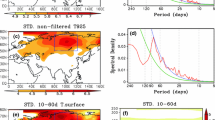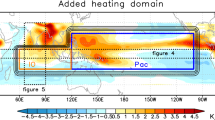Abstract
This study examines the PNA associated atmospheric diabatic heating by linearly isolating the influence of ENSO. The analysis is based on the NCEP–NCAR and ERA-40 reanalyses and a 1,000-year-long integration of the CCCma coupled climate model. Both the vertically integrated and three-dimensional diabatic heating are examined. The Rossby wave sources in association with the PNA are also diagnosed. The PNA-related heating is confined outside the tropics and is dominated by anomalies in the eastern Pacific, with a north–south dipole structure in mid-latitudes and the northern subtropics. The heating anomalies change sign with height in mid-latitudes but have the same sign throughout the troposphere in the northern subtropics. Relatively weak heating anomalies also appear in mid-latitudes, downstream of the heating dipole over North America and the western North Atlantic. The heating anomalies are largely supported by the advections related to the mean state throughout the troposphere, and partially damped by the advections related to the eddy effect, particularly at the upper troposphere over the North Pacific. Broadly similar patterns are seen from the NCEP–NCAR and ERA-40 reanalyses. Yet anomalous heating centers are generally located at relatively lower troposphere for the ERA-40 with respect to the NCEP–NCAR. The tropical heating anomalies are rather weak, remarkably different from those related to ENSO variability. In addition, the Rossby wave source collocates with the atmospheric diabatic forcing in the mid-high latitudes over the PNA sector, and shows no forcing source in the tropics. The results demonstrate possible forcing in the mid-high latitudes, regardless of tropical heating for the PNA teleconnection. The modeled heating and wave forcing anomalies in association with the modeled PNA compare reasonably well with the reanalysis-based estimates, increasing confidence in the observational results. The analysis provides further evidence of the independence of the PNA on ENSO from the diabatic heating point of view.















Similar content being viewed by others
References
Bengtsson L, Hagemann S, Hodges KI (2004) Can climate trends be calculated from reanalysis data? J Geophys Res 109, D11111. doi:10.1029/2004JD004536
Boer GJ (1986) A comparison of mass and energy budgets from two FGGE datasets and a GCM. Mon Wea Rev 114:885–902
Boer GJ, Flato G, Reader MC, Ramsden D (2000) A transient climate change simulation with greenhouse gas and aerosol forcing: experimental design and comparison with the instrumental record for the 20th century. Clim Dyn 16:405–425
Collins M, Sperber K, CMIP Modelling groups (2005) El Niño- or La Niña-like climate change? Clim Dyn 24:89–104
Davey M et al (2002) STOIC: a study of coupled model climatology and variability in tropical ocean regions. Clim Dyn 18:403–420
Deser C, Blackmon ML (1995) On the relationship between tropical and North Pacific sea surface temperature variations. J Clim 8:1677–1680
Deweaver E, Nigam S (2004) On the forcing of ENSO teleconnections by anomalous heating and cooling. J Clim 17:3225–3235
Favre A, Gershunov A (2006) Extra-tropical cyclonic/anticyclonic activity in North-Eastern Pacific and air temperature extremes in Western North America. Clim Dyn 26:617–629
Feldstein SB (2000) The timescale, power spectra, and climate noise properties of teleconnection patterns. J Clim 13:4430–4440
Flato GM, Boer GJ, Lee W, McFarlane N, Ramsden D, Reader M, Weaver A (2000) The Canadian Centre for Climate Modelling and Analysis global coupled model and its climate. Clim Dyn 16:451–467
Fyfe JC, Boer GJ, Flato GM (1999) The Arctic and Antarctic oscillations and their projected changes under global warming. Geophys Res Lett 26:1601–1604
Graham NE (1994) Decadal-scale climate variability in the tropical and North Pacific during the 1970s and 1980s: observations and model results. Clim Dyn 10:135–162
Hartmann D (1995) A PV view of zonal flow vacillation. J Atmos Sci 52:2561–2576
Held IM, Ting M, Wang H (2002) Northern winter stationary waves: theory and modeling. J Clim 15:2125–2144
Hoerling MP, Ting M (1994) Organization of extratropical transients during El Niño. J Clim 7:945–966
Hoerling MP, Kumar A, Zhong M (1997) El Niño, La Niña, and the nonlinearity of their teleconnections. J Clim 10:1769–1786
Horel JD, Wallace JM (1981) Planetary-scale atmospheric phenomena associated with the Southern Oscillation. Mon Wea Rev 109:813–829
Hoskins BJ, Ambrizzi T (1993) Rossby wave propagation on a realistic longitudinally varying flow. J Atmos Sci 50:1661–1671
Hoskins BJ, Hodges KI (2002) New perspectives on the Northern Hemisphere winter storm tracks. J Atmos Sci 59:1041–1061
Hoskins BJ, Karoly D (1981) The steady linear response of a spherical atmosphere to thermal and orographic forcing. J Atmos Sci 38:1179–1196
Hoskins BJ, Valdes PJ (1990) On the exsistence of storm-tracks. J Atmos Sci 47:1854–1864
Hoskins, B. J., H. H. Hsu, I. N. James, M. Masutani, P. D. Sardeshmukh, and G. H. White, (1989) Diagnostics of the global atmospheric circulation based on ECMWF analyses 1979–1989. Tech. document WCRP-27, WMO/TD-no. 326, WMO, 217 pp
Kistler R et al (2001) The NCEP–NCAR 50-year reanalysis: monthly means CD-ROM and documentation. Bull Am Meteor Soc 82:247–268
Lau N-C (1997) Interactions between global SST anomalies and the midlatitude atmospheric circulation. Bull Am Meteor Soc 78:21–33
Leith CE (1973) The standard error of time-average estimates of climatic means. J Appl Meteorol 12:1066–1069
Lin H, Derome J, Brunet G (2005) Tropical Pacific link to the two dominant patterns of atmospheric variability. Geophys Res Lett 32, L03801. doi:10.1029/2004GL021495
Nigam S (1994) On the dynamical basis for the Asian summer monsoon rainfall—El Niño relationship. J Climate 7:1750–1771
Nigam S, Chung C, DeWeaver E (2000) ENSO diabatic heating in ECMWF and NCEP–NCAR reanalyses, and NCAR CCM3 simulation. J Clim 13:3152–3171
Nitta T, Yamada S (1989) Recent warming of tropical sea surface temperature and its relationship to the Northern Hemisphere circulation. J Meteor Soc Jpn 67:375–382
North GR, Bell TL, Cahalan RF, Moeng FJ (1982) Sampling errors in the estimation of empirical orthogonal functions. Mon Wea Rev 110:699–706
Pacanowski RC, Dixon K, Rosati A (1993) The GFDL modular ocean model users guide. GFDL Ocean group technical report 2. GFDL, Princeton, USA, 46 pp
Palmer TN (1999) A nonlinear dynamical perspective on climate prediction. J Clim 12:575–591
Palmer T, Sun Z (1985) A modelling and observational study of the relationship between sea surface temperature in the northwest Atlantic and atmospheric general circulation. Q J R Meteor Soc 111:947–975
Peixoto J, Oort A (1992) The physics of climate, AIP, NY, 520 pp
Rasmusson EM, Mo K (1993) Linkages between 200-mb tropical and extratropical circulation anomalies during the 1986–1989 ENSO cycle. J Clim 6:595–616
Renwick JA, Wallace JM (1996) Relationships between North Pacific wintertime blocking, El Niño, and the PNA pattern. Mon Wea Rev 124:2071–2076
Sardeshmukh PD (1993) The baroclinic problem and its application to the diagnosis of atmospheric heating rates. J Atmos Sci 50:1099–1112
Sardeshmukh PD, Hoskins BJ (1985) Vorticity balances in the tropics during the 1982–93 El Nino-Southern oscillation event. Q J R Meteor Soc 111:261–278
Sardeshmukh PD, Hoskins BJ (1988) The generation of global rotational flow by steady idealized tropical divergence. J Atmos Sci 45:1228–1251
Simmons AJ, Wallace JM, Branstator GW (1983) Barotropic wave propagation and instability, and atmospheric teleconnection patterns. J Atmos Si 40:1363–1392
Straus DM, Shukla J (2002) Does ENSO force the PNA? J Clim 15:2340–2358
Teng Q, Fyfe JC, Monahan AH (2007) Northern hemisphere circulation regimes: observed, simulated and predicted. Clim Dyn 28:867–879
Trenberth KE (1997) The definition of El Niño. Bull Am Meteor Soc 78:2771–2777
Trenberth KE, Solomon A (1994) The global heat balance: heat transports in the atmosphere and ocean. Clim Dyn 10:107–134
Trenberth KE, Barnstator GW, Arkin PA (1988) Origins of the 1988 North American drought. Science 242:1640–1645
Trenberth KE, Branstator GW, Karoly D, Kumar A, Lau NC, Ropelewski C (1998) Progress during TOGA in understanding and modeling global teleconnections associated with tropical sea surface temperatures. J Geophys Res 103:14291–14324
Trenberth KE, Hurrell JW (1994) Decadal atmosphere-ocean variations in the Pacific. Clim Dyn 9:303–319
Trenberth KE, Stepaniak DP, Hurrell JW, Fiorino M (2001) Quality of reanalyses in the tropics. J Clim 14:1499–1510
Uppala SM et al (2005) The ERA-40 re-analysis. Q J R Meteor Soc 131:2961–3012
von Storch H, Zwiers FW (1999) Statistical analysis in climate research. Cambridge University Press, Cambridge, 494 pp
Wallace JM, Gutzler DS (1981) Teleconnections in the geopotential height field during the northern hemisphere winter. Mon Wea Rev 109:784–812
Wallace JM, Smith C, Bretherton CS (1992) Singular value decomposition of wintertime sea surface temperature 500-mb height anomalies. J Clim 5:561–576
Wallace JM, Rasmusson EM, Mitchell TP, Kousky VE, Sarachik ES, von Storch H (1998) On the tructure and evolution of ENSO-related climate variability in the tropical Pacific: lessons from TOGA. J Geophys Res 103:14241–14259
Wang D, Wang C, Yang X, Lu J (2005) Winter Northern Hemisphere surface air temperature variability associated with the Arctic Oscillation and North Atlantic Oscillation. Geophys Res Lett 32, L16706. doi:10.1029/2005GL022952
WCRP (2000) Intercomparison and validation of ocean-atmosphere energy flux fields. WCRP-112, WMO/TD-no. 1036, 303 pp
Wernli H, Schwierz C (2006) Surface cyclones in the ERA-40 dataset (1958–2001). Part I: Novel identification method and global climatology. J Atmos Sci 63:2486–2507
White WB, Chen SC (2002) Thermodynamic mechanisms responsible for the tropospheric response to SST anomalies in the Antarctic circumpolar pages. J Clim 15:2577–2596
Yanai M, Tomita T (1998) Seasonal and interannual variations of atmospheric heat sources and moisture sinks as determined from NCEP–NCAR reanalysis. J Clim 11:463–482
Yu B, Boer GJ (2002) The roles of radiation and dynamical processes in the El Niño-like response to global warming. Clim Dyn 19:539–553
Yu B, Boer GJ (2006) The variance of sea surface temperature and projected changes with global warming. Clim Dyn 26:801–821
Yu B, Zwiers F (2007) The impact of combined ENSO and PDO on the PNA climate: a 1000-year climate modeling study. Clim Dyn 29:837–851
Yu B (2007) PNA associated diabatic heating and its relationship to ENSO. Atmos Sci Lett 8:107–112
Zhang Y, Wallace JM, Iwasaka N (1996) Is climate variability over the North Pacific a linear response to ENSO? J Clim 9:1468–1478
Zwiers FW (1987) A potential predictability study conducted with an atmospheric general circulation model. Mon Wea Rev 115:2957–2974
Acknowledgments
We greatly appreciate the work of G.J. Boer, G.M. Flato, D. Ramsden, C. Reader, W. Lee, and other colleagues at the CCCma in the production of the model results analyzed here. We thank B. Merryfield and Q. Teng for helpful comments on this study, and A. Krol for editing the manuscript. In addition, we would like to thank two anonymous reviewers for their constructive suggestions and advice, which considerably improved the original manuscript.
Author information
Authors and Affiliations
Corresponding author
Rights and permissions
About this article
Cite this article
Yu, B., Tang, Y.M., Zhang, X.B. et al. An analysis on observed and simulated PNA associated atmospheric diabatic heating. Clim Dyn 33, 75–91 (2009). https://doi.org/10.1007/s00382-008-0432-4
Received:
Accepted:
Published:
Issue Date:
DOI: https://doi.org/10.1007/s00382-008-0432-4




